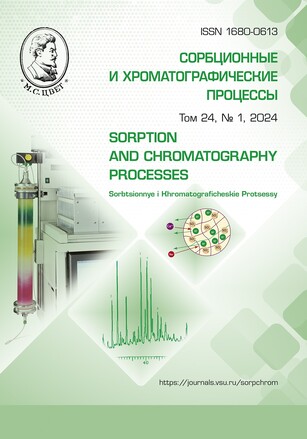Sorption of the Cu, Gd, V, Mn, and Fe elements by hydrogels with identification of their complexes in the solid phase of the polymer ligand using EPR
Abstract
The search for new sorbents for the concentration of substances is among the important tasks of analytical chemistry regarding the monitoring of water bodies in modern times. It is necessary to regularly control water supply sources, and the quality of natural water is also an indicator of the health of ecosystems. The use of sorbents when collecting water for analysis simplifies the preparation of complex samples, allowing to use a solid concentrate to determine the absorbate and quickly record the results using multi-element in situ instrumental methods. We suggested using cross-linked polyacrylates (CLPs) based on polyacrylamide as a new type of sorbent for these purposes. Unlike traditional sorbents, hydrogels noticeably swell in water (рН 4-7), which allows conducting the sorption of elements not only on the surface but also inside CLP granules. Sorption is conducted in a static mode by placing a weighed portion of CLP in a certain volume of water sample and by further drying in air at 70-100°C.
The purpose of this work was to obtain and study solid polymer concentrates of CLP using EPR spectroscopy in order to confirm the sorption of elements in CLP for the further development of methods for the preparation of samples of various water bodies. To do this, we obtained individual and binary polymer complexes of paramagnetic elements Cu(II), Gd(III), V(IV), Mn(II), and Fe(III) from model solutions of their salts (from 10-7 (INAA) to 10-3 (EPR) mol/dm3) and dried them To confirm the sorption and reliable binding of elements into polymer complexes, we used ESR spectroscopy at 293 K. The experimentally obtained new EPR spectra were compared with the theoretical ones. Complex EPR spectra were simulated using original software developed at the Kurnakov Institute of General and Inorganic Chemistry of the Russian Academy of Sciences.
It was shown that upon drying CLPs completely disengaged from water molecules, while the sorption of metals depended on the рН and grew with an increase in the solution’s рН. In case of joint presence, metal ions formed more complex compounds as compared to individual sorption. The hyperfine structure constant (HSC) was calculated for the spectra of complexes with CLPs and g-factor was calculated for all samples. It was determined that in the course of the formation of metal complexes with CLPs, the nearest coordination sphere was greatly distorted, while the nature of the distortion of the ligand environment depended on the element. In case of the Cu(II) and V(IV) system, we observed additivity of the EPR spectra, but in case of Cu and Gd(III) it was not recorded. In any case, the formation of strong and stable polymer complexes was confirmed.
Sorption concentration using CLPs was proposed as a method of sample preparation of natural and technogenic water systems by transferring the determined ions into a solid hydrogel concentrate in order to be further analysed using multi-element instrumental methods (for example, X-ray fluorescence analysis (XRF), instrumental neutron activation analysis (INAA), etc.).
Downloads
References
Dubrovskii C.A., Vasil'ev V.V. Davlenie nabukhaniya I uprugoe povedenie polimakromonomernykh setok s razlichnoi funktsional'nost'yu uzlov. Vysokomol. soedineniya. Ser. A. 2006; 48(9): 1595-1607. https://doi.org/10.1134/S0965545X06090070 (In Russ.)
Shcherbakova (Simakina) Ya.I., Efimov N.N., Mikhailova A.V., Savvin S.B., Minin V.V. Osobennosti kom-pleksoobrazovaniya perekhodnykh metal-lov s gidrogelyami. Zhurn. neorg. khimii. 2013; 58(7): 936-939. https://doi.org/10.7868/S0044457X13070210 (In Russ.)
Ahmed E.M. Hydrogel: Preparation, characterization, and applications. J. Adv. Res. 2015; 6(2): 105-121. https://doi.org/10.1016/j.jare.2013.07.006
SimakinaYa.I., Kuz'minaT.G., SeninV.G. Issledovanie sorbtsionnykh svoistv polimernykh gidrogelei na osnove akrilamida spektral'nymi metodami analiza. Zhurn. analit. khimii. 2021; 76(11): 997-1003. https://doi.org/10.31857/S0044450221110141 (In Russ.)
Khamizov R.Kh. Metody matematicheskogo modelirovaniya protsessov sorbtsionnogo kontsentrirovaniya i razdeleniya i vozmozhnosti ikhispol'zovaniya v analize rastvorov. Sorbtsionnye i khromatograficheskie protsessy.2012; 12(1): 5-22. (In Russ.)
Belford G.G., Belford R.L., Burkhaven J.F. Eigenfields: A practical direct calculation of resonance fields and intensities forfield-sweptfixed-frequency spectrometers. J. Magn. Res. 1973; 11(2): 251-265. https://doi.org/10.1016/0022-2364(73)90010-3.
Landau L.D., Lifshits E.M. Kvanto-vayamekhanika. Nerelyativistskaya teori-ya. M., Nauka, 1974. 752 p. (In Russ.)
Rakitin Yu.V., Larin G.M., Minin V.V. Interpretatsiya spektrov EPR koordi-natsionnykh soedinenii (Interpretation of EPR Spectra of Coordination Compounds), M., Nauka, 1993, 398 p. (In Russ.)
Lebedev Ya.S., Muromtsev V.I. EPR I relaksatsiya stabilizirovannykh radikalov (EPR and Relaxation of Stabilized Radi-cals), M., Khimiya, 1972, 256 p. (In Russ.)
Wilson R., Kivelson D. ESR lin-ewidths in solution. I. Experiments on ani-sotropic and spin – rotational effects. J. Chem. Phys. 1966; 44(1): 154-168. https://doi.org/10.1063/1.1726439
Lazarev A.I., Kharlamov I.P., Yakovlev P.Ya. Spravochnik khimika-analitika (Handbook for Analytical Chem-ists). M., Metallurgiya, 1976, 183 p. (In Russ.)
Ermolaeva V.N., Mikhailova A.V., Kogarko L.N., Kolesov G.M. Vyshchela-chivanie redkozemel'nykh I radioaktivnykh elementov iz shchelochnykh porod Lovezerskogo massiva (Kol'skii polu-ostrov). Geokhimiya. 2016;54(7): 651-658. https://doi.org/10.7868/S0016752516070049







